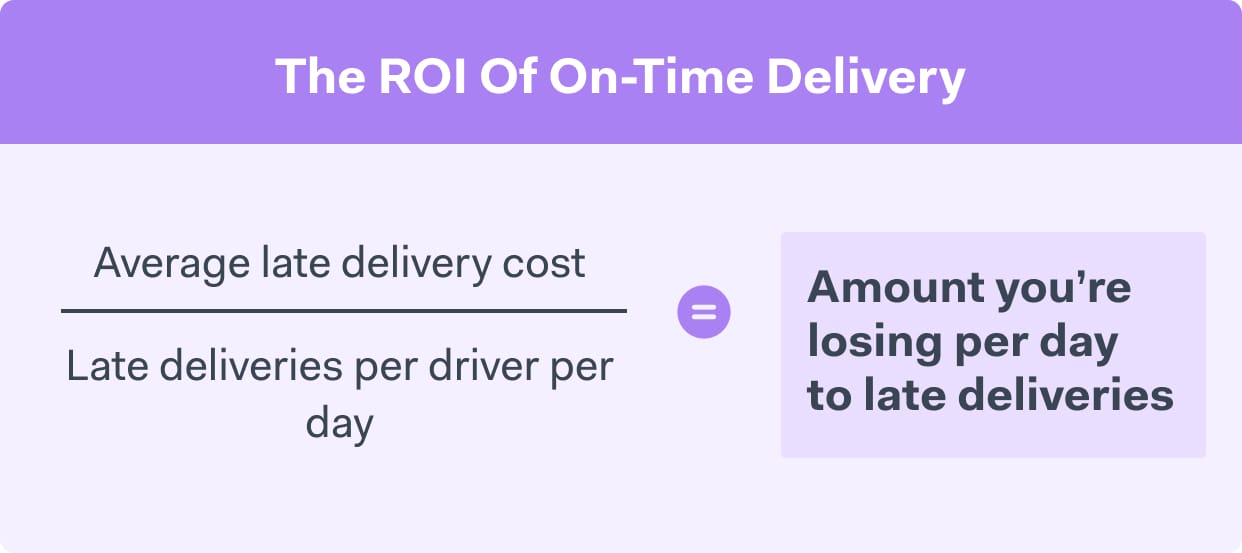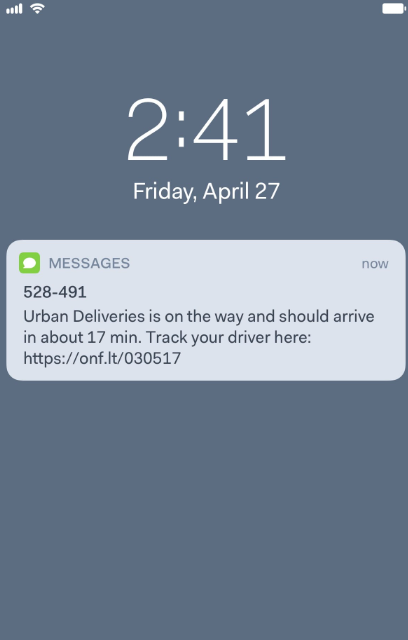Everyone knows that metrics are important. But how do you actually quantify the success of your strategy? We've made it easy. Here is our free on-time ROI calculator with the formulas spelled out. We even have three key steps that you can take today to improve that number.

What’s On Time Delivery ROI?
In the courier industry, late deliveries can significantly drive up costs. But how much? On time delivery ROI tells you exactly how much you lose per day due to late parcel deliveries – and how much you could save by improving that number.
Why Is ROI Important?
Operating a business without understanding your ROI is like driving without a map–even if you’re headed in the right direction, you don’t really know where you’re going. Knowing your ROI can help you to:
- Make resource allocation efficiently - you know clearly what is bringing you profit
- Improve decision-making - as you’re following what improves your margins
- Clear cash management - you are focused on what brings you growth and ROI helps you to understand your net profit.
- Cut operational inefficiencies - you can see when costs or inefficiencies increase and can take steps.
How to Calculate On Time Delivery ROI
To calculate your on time delivery return on investment you take:
Average late delivery costs * Late deliveries per day

This will give you the amount you’re losing every day to late deliveries. Which shows you the amount that you could gain back by improving your on-time deliveries.
To help you calculate your business’s on time delivery ROI, we created a unique calculator to do the math for you.
3 Immediate Steps to Improve On Time Delivery ROI
Now that ROI is clear, and you know how to calculate it. Now we’re going to look at 3 steps to improve your on time delivery ROI.
1 - Look Into A Courier Delivery Managament Software
A courier delivery management software will route your deliveries in the most efficient way. It also provides real-time feedback on routes, delivery status, and customer responses.
Delivery software may be an increase in costs, but it more than pays off with the benefits of:
- Improved efficiency: Streamlined deliveries, reduction of manual errors, and cut fuel costs by up to 45%
- Optimized resources: Improve routes and reduce vehicle maintenance costs, also by reducing fuel you become more sustainable
- Increase customer satisfaction: Using predictive ETAs, customers know when their delivery will arrive and if it’s delayed. This information improves their loyalty and satisfaction with your brand.
Here’s how to find and evaluate courier delivery software options. If you have specific needs that fall outside the traditional offerings, you can always explore a custom courier delivery software offering.
2 - Optimize Your Last Mile Courier Delivery Routes
Delivery routes can often be inefficient with various locations, fluctuating traffic, and different driver needs. However, more intelligent routing can reduce costs by as much as 40%.

Routing optimization reduces time and labor costs by auto-assigning drivers and directions based on real-time location and traffic. The software automatically re-routes drivers based on potential delays. You can even filter results across your fleet by driver, customer, and/or delivery status.
3 - Automatic Status Updates for Customers
You can’t always prevent delays. But you can mitigate their negative effects by promptly communicating with your customers.
Look for software that provides some of the following features:
- Direct Notifications and Communication: Choose software that automatically updates customers when a delivery has started, when it’s expected, and when it’s arriving. An automated SMS feature makes this process seamless. However, you can also choose to add an option for a customer to be able to contact a driver directly.

- Proof of Delivery: Make sure there is no miscommunication about a delivery completion. A solution that integrates photos, bar codes, or signatures means that all deliveries are properly logged.
- Real-time GPS Driver Tracking: This feature shows customers exactly where their driver is at any given moment.
For an example of this type of courier delivery software, check out what Onfleet’s courier features have to offer, or reach out directly to our team. We’d love to talk about your needs and how we can help.
One Key Change For Your On-Time Deliveries
To make a huge difference to your on-time delivery, and your delivery business in general, try Onfleet.
Improve routes, driver satisfaction, client communication, and reporting using Onfleet. Start your 14-day free trial here.

